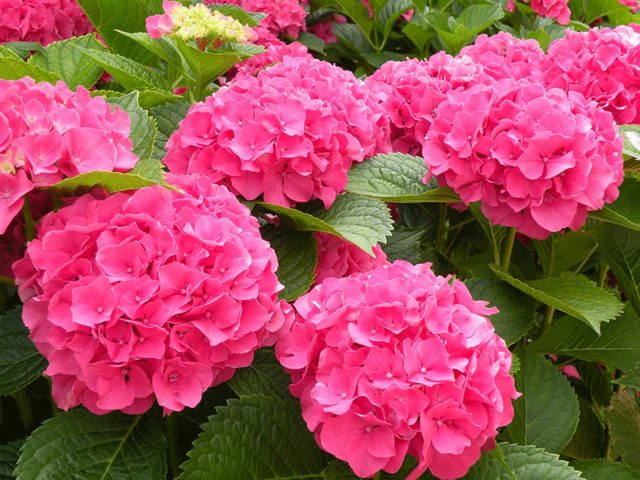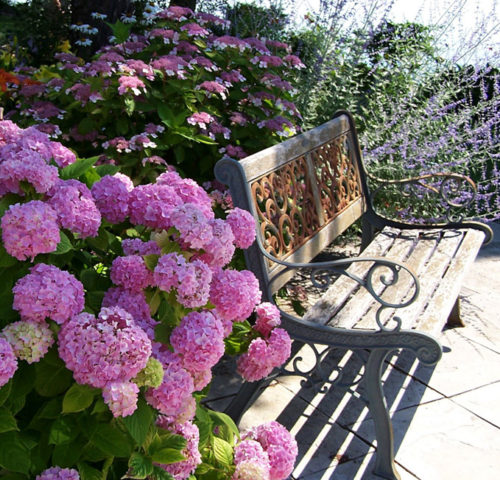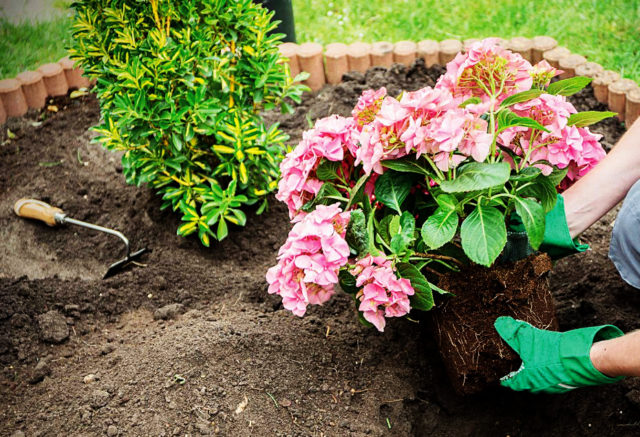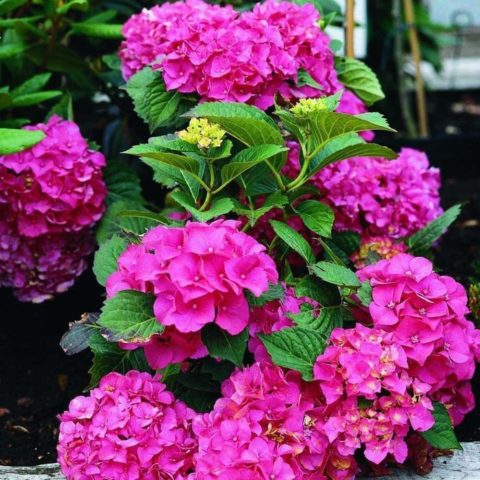Content
Hydrangea Masya is an ornamental perennial shrub with numerous and massive inflorescences that cover the whole plant in summer. Creates a beautiful composition with a wonderful aroma in any front garden, looks great in flowerpots and pots. There are many different varieties of hydrangea, but Masya is especially beautiful.

A flowering plant can decorate a terrace, balcony and flower beds
Description of hydrangea Masya
This remontant variety has long earned popularity in European countries, but the plant became widespread in Russia only a few years ago. Its lush crown begins to bloom with large bright flowers in early July and pleases gardeners with its beauty until the end of September. The bush has large leaves of bright green color, erect shoots, which sometimes need a garter. The flowers are collected in spherical inflorescences up to 30 cm in diameter. The color of the buds is purple or dark pink, but the shade may vary depending on the acidity of the soil. "Masya" grows quickly, has a compact shape and does not exceed 120 cm. This type of hydrangea is demanding on moisture and soil composition, is thermophilic, and needs shelter before winter. Frost resistance of the "Masya" grade up to -18 °FROM.
Hydrangea large-leaved Masya in landscape design
The hydrangea bush, thanks to its large leaves and lush inflorescences, looks attractive both in a single planting and in combination with other plants in the center of the lawn. Look spectacular with boxwood, blue spruce and juniper. Emphasizes the merits of a composition of shrubs with delicate, small foliage and small flowers. In a group planting, fern, hosta, ornamental grasses, geraniums, spiraea and other beautifully flowering shrubs will become excellent neighbors of hydrangea. You can organize planting in pots, boxes, flowerpots, plant a bush on a balcony or veranda. A flower bed with the "Masya" variety is appropriate for a garden in French, English and rustic styles. Flowering shrubs serve as a magnificent decoration for hedges, decorate gazebos and terraces, and perform the function of zoning.

"Masya" goes well with almost all plants in the garden
Winter hardiness of hydrangea Masya
Hydrangea "Masya" is on the list of frost-resistant shrub varieties, for which domestic gardeners fell in love. But despite the fact that it is able to withstand a drop in temperature to -15-18 °C, it is not recommended to leave the bush without shelter.
In the conditions of central Russia, the hydrangea "Masya" begins to be prepared for winter from the beginning of autumn. And before the onset of frost, the branches are bent to the ground, covered with foliage, hidden under a covering material, or dropped in like roses. But even if all the rules of preparation are followed, there is a possibility that the plant will freeze and will not please with flowers next year.
Planting and caring for hydrangea Masya
The place for planting the Masya hydrangea bush should be chosen very carefully. It is from him that the flowering and decorativeness of the plant will depend. The variety is very picky, it requires careful and attentive care, regular watering and feeding with nutritious fertilizers.It is very important to conscientiously prepare the hydrangea "Masya" for winter and properly prune.
Selection and preparation of the landing site
Best of all, "Masya" feels on fertile, drained, loamy, loose soil, in a well-lit place. This plant is sun-loving, tolerates partial shade. Only the planted bush must be protected from bright sunlight. It is better to choose a site without drafts - near a hedge or buildings. The composition of the soil can be both alkaline and acidic, but in no case is it calcareous. Ideally, the pH should be between 5.5 and 6.
Landing rules
Hydrangea "Masya" takes root best of all during spring planting, when the threat of frost has passed. Although the plant loves a lot of light, it is not advisable to choose an area for it in direct sunlight. Also, do not deeply deepen the seedlings, 2 cm will be enough. But it is imperative to mulch the soil. Needles or sawdust are good for this.
Planting hydrangeas is carried out in 5 stages:
- Before planting the plant, you need to dig a hole 50x50x50 cm.
- Pour mulch and peat mixture on its bottom.
- Place the bush by gently spreading the roots.
- Cover it with earth, compact.
- Water abundantly.
After planting, follow-up care consists of regularly moistening, loosening and fertilizing the soil.

The optimal time for planting hydrangeas is considered to be late spring - early summer.
Watering and feeding
Since "Masya" loves moisture and is very picky about watering, each of her bush should receive at least 2 buckets of water per week. It is advisable to water the plant 2-3 times a month with the addition of alum.
Top dressing should be carried out at least 4 times:
- In May - to activate the growth of hydrangea.
- In early July - for setting new buds.
- In August - to extend the flowering period.
- In September - in order to recuperate.
During the first feeding, it is advisable to add 30 g of sulfuric potassium and superphosphate, 20 g of urea (per sq. M.) Under each bush. When budding begins, it is better to fertilize the hydrangea "Masya" with potassium sulfate (40 g) and superphosphate (70 g). By the end of flowering, the plant needs to be fed with rotted manure (15 kg per bush) or compost.
From organic matter "Masya" well perceives mullein solution.

For a rich hydrangea color, you need to monitor the pH balance of the soil.
Pruning hydrangea Masya
"Masya" is a variety that needs to form bushes every year. Many gardeners prefer to carry out this procedure in the spring, usually in May. Correct pruning consists in shortening the shoots by 3-5 buds, while leaving up to a dozen of the strongest ones. Full pruning of the bush will result in no flowering, as the hydrangea forms buds on the shoots of the last season. To stimulate their new appearance, it is required to regularly break off dry, broken and dead inflorescences. Leaves left over after winter also need to be removed.
Preparing for winter
Hydrangea "Masya" is not a completely frost-resistant variety; it must be covered for the winter. They begin to prepare the bushes for the cold in September. First, they stop watering, then the lower leaves are removed, giving the shoots the opportunity to lignify. In the second half of October, all hydrangea foliage is removed, leaving only the one that protects the buds. Then the branches are carefully tilted to the surface of the earth, laid on a pre-laid spruce branches, pressed with a brick and covered. To protect the shoots of the plant, straw is well suited; peat, leaves or pine bark are often used to cover the roots.

It is easier and safer to cover the hydrangea "Masya" with a special material for the winter
Reproduction
Hydrangea of the "Masya" variety reproduces in several ways:
- by dividing good bushes;
- herbaceous cuttings;
- horizontal taps.
In the first case, it is advisable to carry out the operation in the spring, then a positive result is almost 100% guaranteed. To do this, the bush is dug up, examined, the roots are cut, the cuts are sprinkled with charcoal or treated with brilliant green. Then "delenki" are planted in prepared holes.
When propagating by cuttings, they dig out the rooted part of a non-flowering shoot, transplant it into a pot, shorten the leaves and cover with a plastic bag. The plant is planted in a permanent place no earlier than 3 weeks later.
Layers can be obtained by bending the branch to the ground and sprinkling it with a layer of moist soil. When the shoot takes root, it can be replanted.
When buying a hydrangea seedling "Masya", you need to pay attention to the condition of the plant, and give preference to a bush in a container or pot.
Diseases and pests
Even with careful care of the health of the hydrangea, it can be subject to various diseases and be affected by insects. The main ailments of the Masya variety include:
- white rot;
- fusarium;
- septoria;
- powdery mildew;
- ring spot.
Of the pests, hydrangeas are most often attacked by:
- leaf aphid;
- spider mite;
- nematode;
- slugs.
To make the plant more resistant to pests and diseases, it is advisable to water it several times a season with a weak solution of potassium permanganate. And in preparation for winter, process the bushes with Bordeaux mixture.

The correct planting site, light, acidic soil, sufficient watering and timely feeding guarantee the health of the hydrangea.
Conclusion
Hydrangea Masya, despite its tropical origin, can grow in temperate and continental climates. The main thing is to properly care for it, water it on time and feed it properly. If all the recommendations are followed, the plant will thank the gardener with stunningly beautiful and abundant flowering for a long time.








